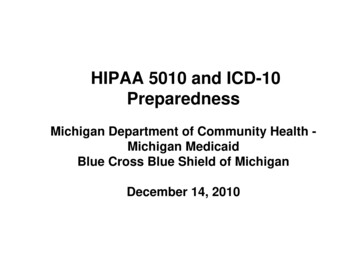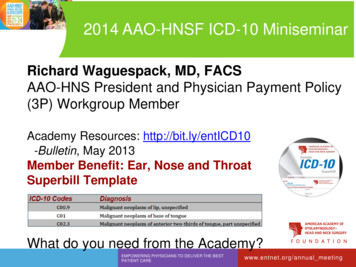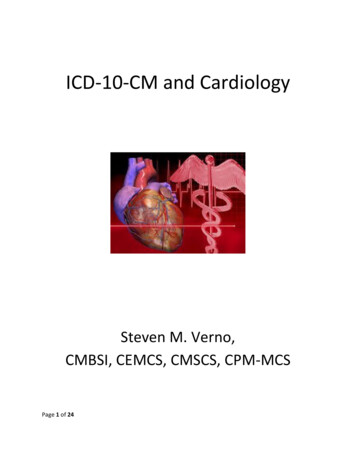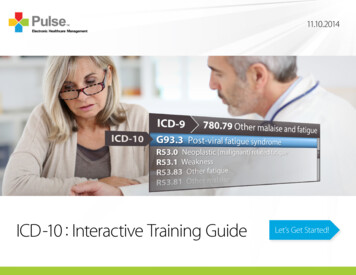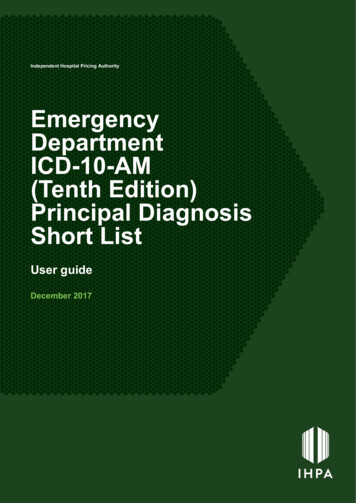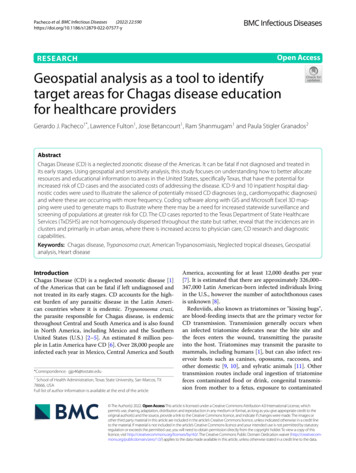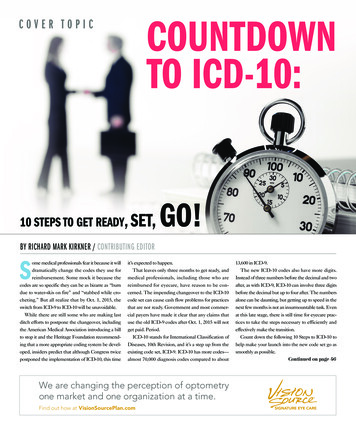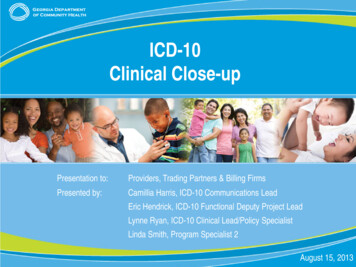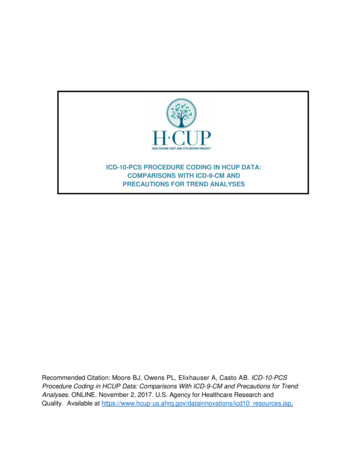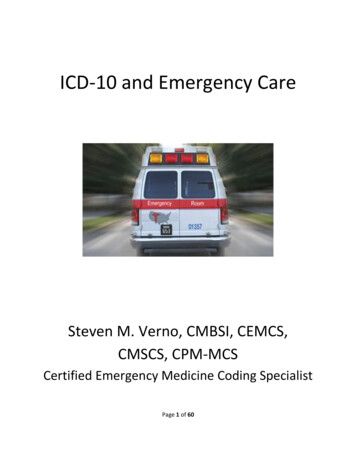
Transcription
ICD-10-CMSICD-10-CMsOVERVIEWThe International Statistical Classification of Disease and Related Health Problems, ICD10, is a medical classification system for coding of: Diseases Injuries Symptoms Procedures and moreThis is the first major change in U.S. coding in more than 30 years.Some call it healthcare’s version of Y2K.ICD-10 expands diagnosis code selections to 68,000 , compared to 14,000 ICD-9-CMselections.CURRENT REGULATIONEffective January 1, 2012, ICD-9 codes were required to be submitted on electronicambulance claims to represent a patient’s condition. The determination of what issubmitted is based on the Medicare Administrative Contractors (MACs). Option 1: Suppliers may choose codes from the Medical Conditions List providedby the Centers for Medicare & Medicaid Services (CMS) that correspond to thecondition of the beneficiary at the time of pickup, then report the codes in thePage 1
ICD-10-CMSdiagnosis field on the claim. The codes in the Medical Conditions List are taken fromthe ICD-9-CM diagnosis code set. Option 2: Suppliers may report the ICD-9-CM (or ICD-10-CM when appropriate)diagnosis code that is provided to them by the treating physician or otherpractitioner. Option 3: Suppliers may report the ICD-9-CM diagnosis code 799.9 unspecifiedillness. Some ambulance services submit ICD-9 codes based on their MACs local coveragedetermination policy (LCD).COMPLIANCE DATEOn August 24, 2012, the Department of Health and Human Services (HHS) issued a FinalRule that delayed the compliance date for the new ICD-10 diagnosis and procedure codesuntil October 1, 2014.The previous compliance deadline of October 1, 2014 was delayed again when PresidentBarack Obama signed a new law on April 1, 2014. This law ordered HHS to not set an ICD10 deadline any sooner than October 1, 2015. In September 2014, the U.S. Department ofHealth and Human Services (HHS) issued a rule finalizing Oct. 1, 2015 as the newcompliance date for health care providers, health plans, and health care clearinghouses totransition to ICD-10.Any provider covered by the Health Portability and Accountability Act (HIPAA) must makethe transition to ICD-10s (MLN Matters Number SE1239).Claims for services provided on or after the compliance date should be submittedwith ICD-10 diagnosis codes.Page 2
ICD-10-CMSClaims for services provided prior to the compliance date should be submitted withICD-9 diagnosis codes.DEPARTMENT OF HEALTH AND HUMAN SERVICESMEDLEARN Matters-SE 1409Effective October 1, 2015ICD-10 Claims Submission Alternatives For from dates of services for professional and supplier claims, or discharge dateson institutional claims on or after October 1, 2015 entities covered under the HealthInsurance Portability Act (HIPAA) are required to use the ICD-10 code sets adoptedunder HIPAA. If a provider or supplier is unable to complete the necessary system changes tosubmit claims with ICD-10 codes by October 1, 2015, or if it finds they are unableto submit claims on or after October 1, 2015, due to issues with its billing software,vendor, or clearing house, the following claims submission alternatives areavailable:NOTE: Claim submission alternatives still REQUIRE the use of ICD-10 code sets for FROMdates of service (on professional and supplier claims) or date of discharge (on institutionalclaims) on or after October 1, 2015.Free Billing Software Free billing software is offered by CMS via the Electronic Data Interchange(EDI) via each MACs website. This billing software only works for submitting Fee-for-Service claims toMedicare. It is intended to provide submitters with an ICD-10 compliantclaims submission format; it does not provide coding assistance.Page 3
ICD-10-CMSNOTE: Submitting electronic claims to Medicare using the free billing software does notchange the requirement for ICD-10 compliant claims to be submitted for FROM dates ofservice on or after October 1, 2015. Any claims containing ICD-9 codes for FROM dates ofservice on or after October 1, 2015, will be rejected by Medicare.Direct data entry Providers that bill institutional claims are also permitted to submit claimselectronically via direct data entry (DDE) screens. For more information aboutDDE, go to http://medicare.fcso.com/Direct data entry/. A request to submit claims via DDE must be done by prior to October 1, 2015.Please note that claims submitted via DDE must contain ICD-10 codes for dates ofdischarge/through dates on or after October 1, 2015. Those submitted containing ICD-9codes for dates of discharge/through dates on or after October 1, 2015, will be returned toprovider (RTP).Paper claims In limited situations, provider and suppliers may submit paper claims withICD-10 codes to Medicare. To find more information on when you maysubmit paper claims, cBillingEDITrans/ASCAWaiver.html NOTE:A wavier must be submitted before October 1, 2015.Submitting paper claims to Medicare, even if approved for an AdministrativeSimplification Compliance Act (ASCA) waiver, does not change the requirement for ICD-10compliant claims to be submitted for FROM dates of service (on professional and supplierclaims) or dates of discharge/through dates (on institutional claims) on or after October 1,2015.Letter from CMSPage 4
ICD-10-CMSOn July 6, 2015, CMS provided a letter to providers and suppliers detailing that CMS willbe: Flexible in claims auditing and quality reporting process. CMS will set up a communication and collaboration center for monitoring theimplementation of ICD-10s. CMS will create an ICD-10 Ombudsman to help triage physician and provider issues. Further information can be found at www.cms.gov/ICD10.GEARING UP FOR CHANGE Change is not easy to embrace, even if the outcome is for the better. Reasons for change:o We have to change because the current process is broken; oro There is a better way to accomplish a task or goal.WHY THE CHANGE?Clinical Better outcomes resulting from better documentation. Paints a better picture due to specificity, laterality, and more detailed informationabout the disease process. Improvement of care due to the documentation on higher acuity patients. Help to design better protocols. Provides more precise information reporting to the State and other Public Healthentities. Improved tracking of patient illnesses. Provides more data for research to develop better patient outcomes; currentsystem (ICD-9) is archaic compared to other countries.Page 5
ICD-10-CMSOperational Improved definitions of patient conditions. For institutional providers, helps with greater specificity to define co-morbiditiesand complications. The ability to share better data based on patient and population.Financial Better documentation increases our understanding of patient complexity and levelof care, supporting reimbursement for the level of care provided. Allows for better comparison for benchmarking patient conditions. May aid in lowering audits due to more specific codes supported by greaterdocumentation.Page 6
ICD-10-CM CONCEPTSICD-10-CM ConceptsICD-9-CMOnly 17 ChaptersICD-10-CM21 ChaptersPage 7
ICD-10-CM CONCEPTSDOCUMENTATION FOCUS AREAS Disease typeDisease acuityDisease stageSite specificLateralityCombination codesChanges in timeframes with certain codesDIFFERENCESPage 8
ICD-10-CM CONCEPTSPage 9
ICD-10-CM CONCEPTSPage 10
ID-10-MS Page t diagnosis field on the claim. The codes in the Medical Conditions List are taken from the ICD- {-CM diagnosis code set. Option 2: Suppliers may report the ICD- {-CM (or ICD- s r-CM when appropriate) diagnosis code that is provided to them by the treating physician or other practitioner.

